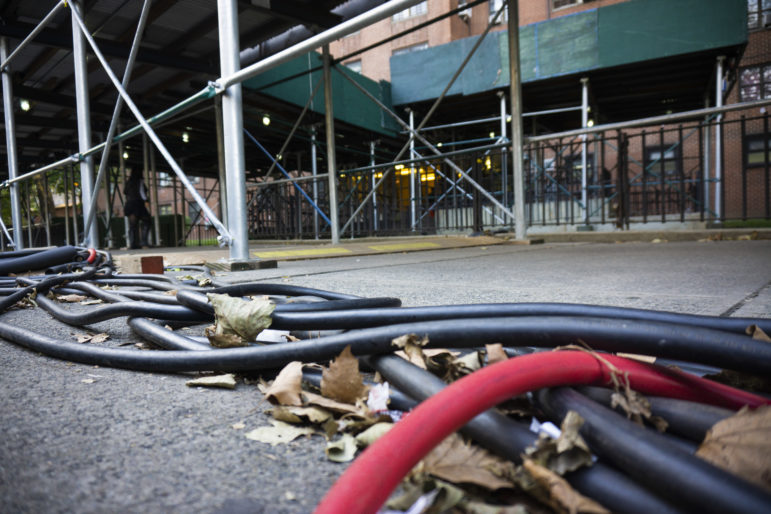
Gaspard Le Dem
The Andrew Jackson Houses need more than $13 million in electrical repairs, including $3.4 million to fix the development’s transformer
Outside the Andrew Jackson Houses on Halloween night, the over-excited screams of trick-or-treaters were drowned out by the roar of a 1000-kilowatt diesel generator parked in front of the housing complex.
All seven buildings of the NYCHA complex, located in the Melrose neighborhood of the Bronx, have been running on generator power since the development’s transformer burned out in April.
The precarious electrical situation at the Jackson Houses, which are home to 2,357 people, has led to chronic power outages that trap people in elevators and send over-heated residents to the hospital, residents say.
Blackouts happen on a near daily basis–sometimes up to four times a day–says Danny Barber, as he sat outside the development giving out big handfuls of Skittles, Nerds and M&Ms from a pushcart full of candy.
“Fix the power–it isn’t right,” says Barber, a lifelong resident of the Jackson Houses and the chair of the Citywide Council of Presidents of NYCHA tenant associations. “The people of NYCHA–you don’t respect your residents. You don’t treat your residents as they should be treated. Do better or get out of the business.”
NYCHA has put off a much-needed overhaul of the electrical system at the Jackson Houses for years, Barber says.
“I am at my wit’s end with NYCHA,” wrote Barber in an email to NYCHA from July 9.
During a recent power outage, Barber injured his shoulder by prying open the doors of the elevator he was trapped in with a senior resident, he says
“I don’t do confined spaces,” says Barber. “I freak out.”
The electrical issues come just months after Governor Andrew Cuomo decried the conditions at the Jackson Houses in a televised visit of the NYCHA development last March.
After reports of freezing temperatures, toxic mold, vermin infestations and other health hazards in public housing across the city, Cuomo signed off on a $250 million package in additional state resources to “improve living conditions at NYCHA.”
But on Halloween night, residents said living conditions at the Jackson Houses had only gotten worse since the governor’s visit.
Eva Johnson, 62, said she was transported to the hospital with respiratory problems in September, when the power went out on a hot day.
“EMS said that my house felt like it was 110 degrees,” said Johnson, who has lived at the Jackson Houses since they were built in 1963. “It’s sickening–it’s been out too long.”
As she pushed her walker on the sidewalk, Johnson avoided the tangled power lines running from the generator to her building.
Johnson said she rarely leaves her building these days for fear of getting stuck in an elevator during an outage.
“I took a chance,” Johnson said. “I came outside because I need some air–because I’ve been in the house for I don’t know how many days or weeks.”
Darlin Rivas, who has lived at the Jackson Houses for five years, said she had to take her sons to the emergency room this summer because her apartment got too hot during a power outage.
“They get really suffocated,” said Rivas, whose two boys suffer from chronic asthma. “They have to use the nebulizer.”
Yvette Bridgett, who lived in the Jackson Houses for 38 years before moving out in 2007, said the housing complex has fallen into serious disrepair.
“I’ve never seen anything like this that’s going on,” said Bridgett, who was visiting old friends at the Jackson Houses on Wednesday night.
“It’s falling apart right in front of us.”
The Andrew Jackson Houses need more than $13 million in electrical repairs, including $3.4 million to fix the development’s transformer, according to a the authority’s 2017 physical needs assessment.
The report estimates the total cost of repairs at the Jackson Houses at more than $210 million.
NYCHA has a legal obligation to provide utilities to their tenants under local and state law, says Redmond Haskins, the deputy communications director at The Legal Aid Society.
“When they fail to meet that obligation, there are consequences,” Haskins says. “It’s the same kind of covenant that you have with your landlord: If the unit is not habitable then there are consequences.”
The Jackson Houses are just one of many NYCHA developments where aging infrastructure has led to poor living conditions.
At the Pomonok Houses in Queens, trash chutes regularly overflow due to failing compactors that are more than 50 years old, says Tamika Williams-Moore, president of the Pomonok Houses Residents Association, on Wednesday.
“You have this whole chute–all the way up to the 7th floor from the basement–full of garbage,” says Williams-Moore.
The towers of trash have summoned an army of rats, flies and maggots to the housing project, which houses more than 4,200 residents in Flushing.
“The whole building stinks–it’s a hot mess,” says Williams-Moore. “There hasn’t been any real oversight, so now we’re here.”
NYCHA estimates that the Pomonok Houses need roughly $140 million in mechanical repairs, and a whopping $654 million in repairs overall.
In June, Mayor Bill de Blasio announced the city had secured $400 million in public private partnerships for “major renovations” at 21 NYCHA developments in Brooklyn and Manhattan.
But with 2,413 buildings across the city, and 70 percent of them built before 1969, NYCHA repairs still have a long way to go.
“NYCHA has a nearly $32 billion need in capital funding to address its aging housing portfolio,” says Chester Soria, deputy press secretary at NYCHA.
Soria did not provide a timeline for repairs at the Jackson Houses.
Roughly 5 percent of New York City’s population lives in NYCHA housing, a total of around 404,000 residents, according to the agency’s estimates.
Based on estimates by the World Population Review, this would make NYCHA the 47th largest city in America, ahead of major cities like Cleveland and New Orleans.







